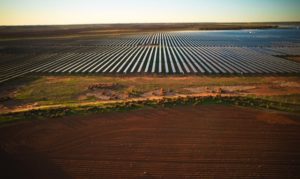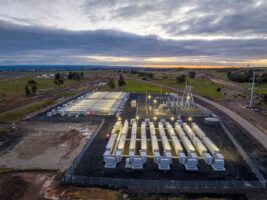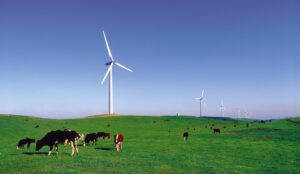General Electric, now ranking with Vestas as the biggest maker of wind turbines in the world, has announced that it will supply three of its new turbines that include battery storage as part of an 86-turbine order for a new Texas wind farm.
GE says its modestly named 2.5-120 Brilliant turbine will incorporate short-term power-storage capabilities, using software to analyse wind speeds and batteries to retain excess power during gusty periods so that electricity can be fed into the grid when wind declines, thus smoothing the output.
As the online magazine Quartz reports today, the rap against wind energy is that it’s fickle, generating massive amounts of electricity one hour and next to nothing the next.
But what if every wind turbine became a node in an energy internet, communicating with the grid and each other to adjust electricity production while storing and releasing electricity as needed? That, it says, is the idea behind GW’s Brilliant turbine, which captures tens of thousands of data points each second on wind and grid conditions and then adjusts production, storing electricity in an attached 50kWh sodium nickel chloride battery.
“This provides a path for lowering the cost of energy even more,” Keith Longtin, general manager of GE’s wind product line, told Quartz. “We think by being able to integrate the storage into the turbine and by being able to provide predictable power it’s going to minimize a lot of the balancing the grid has to do today.”
The Quartz article continues:
That’s also good for the environment. Currently, utilities rely on carbon-spewing natural gas-fired power plants to balance electricity generated from intermittent renewable energy sources like wind and solar.
The turbine’s algorithms predict what electricity generation and demand will be over the next 15 minutes to an hour and adjust production accordingly. The battery can store up to 60 minutes of electricity.
That could mean more revenue for wind farm operators. When turbines generate more electricity than the grid can accommodate, that power is wasted. If they can store that power for later use, then they can get paid for the power. And some state regulators are willing to pay for so-called frequency regulation services, where a power producer stores and releases electricity to help keep the grid balanced as demand and supply fluctuates.
GE declined to say how much the brilliant turbine costs compared to a conventional windmill. But the technology may prove attractive to wind farm operators as states like California begin to require utilities to provide energy storage when building new power plants.
Longtin said GE also has its sights on the European market, where a number of countries are considering legislation to require power producers to provide predictable electricity generation.
On its own website, GE says the 2.5-120 turbine is first to utilise the “Industrial Internet” to help manage the variability of wind providing smooth predictable power to the world. It says the integration of energy storage, drives higher wind farm output, improves services productivity and creates new revenue streams for customers. It estimates that it captures a 25 per cent increase in efficiency and 15 per cent increase in power for low wind speed sites










